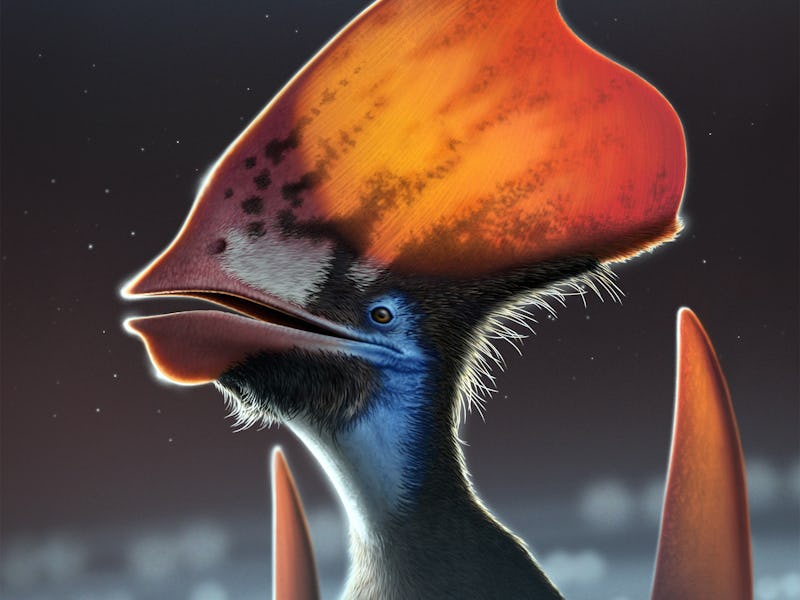This ancient creature developed feathers long before the dinosaurs
A specimen found in Brazil pushes back the timeline for the origin of feathers.

It’s hard to imagine birds without their feathers. From the vibrant coats of tropical parrots to the rainbow of browns worn by sparrows and house finches, feathers make it possible for birds to fly, regulate their body temperatures, camouflage, and attract mates.
There’s substantial evidence that theropod dinosaurs, the ancestors of modern birds, also wielded feathery coats. But the origin of feathers is still up for debate. Recent research shows that the flying cousins to dinosaurs, pterosaurs, may have had feathers as well — an assertion that would not only change our understanding of what pterosaurs looked like, but significantly push back the timeline for feather evolution as well.
Writing this week in the journal Nature, researchers examine the specimen of a pterosaur from the Early Cretaceous that likely had feathers, and colorful ones at that.
Here’s the background — Pterosaurs soared through Earth’s skies as early as 220 million years ago in the Triassic period, before going extinct with their dinosaur cousins at the end of the Cretaceous. They share a common ancestor with dinosaurs, but exist as their own class of ancient, flying reptiles.
Many pterosaur fossils have hair-like structures called pycnofibers. It’s not entirely sure what pycnofibers were used for or what exactly they looked like, though some research shows that they might actually be early feathers.
In 2018, researchers reported in the journal Nature Ecology and Evolution that the pycnofibers of two juvenile pterosaur specimens from China appeared to take on several forms. Some were simple and tube-shaped, but others appeared to branch apart. Instead of it all resembling individual hairs, some of the fluff on these Jurassic-era pterosaurs looked more like primitive feathers.
“The style of branching was not similar to that of birds, but it was similar to some dinosaurs,” Marie McNamara, a paleobiologist at University College Cork in Ireland and a co-author of the report, tells Inverse.
The 2018 study marked the first time that branched feathers were reported in any pterosaur, McNamara says. Then another specimen showed up in Brazil. The new pterosaur was an adult and lived during the Early Cretaceous, millions of years after the two juveniles from China.
McNamara and colleagues analyzed the new specimen for this week’s report in Nature. They found more evidence of branched feathers in pterosaurs, and show that the style of their feathers had a bit in common with modern birds.
An artist’s rendering of a pterosaur with a bright red crest.
What they discovered — The specimen from Brazil reveals the partial skull of a medium-sized pterosaur, Tupandactylus imperator. The feather-like structures branch from an area just below the pterosaur’s head crest, and a bit of soft tissue was also preserved on limestone slabs.
This pterosaur had two types of fuzz on its body: tube-shaped monofilaments like hair or whiskers, and branching feathers. Compared to the juvenile specimens from the 2018 report, the feathers take on a shape more similar to that of birds.
“The feathers show successive branching the whole way along the shaft, except for a naked part at the bottom of that probably inserted into the skin,” McNamara tells Inverse.
The researchers also scanned the soft tissue via electron microscopy to look for organelles called melanosomes, which store and produce melanin. These indicators would be able to identify if the feathers were colorful like the ones we see today.
Branched feathers found in fossilized limestone in Brazil.
Sure enough, melanosomes were plentiful in both skin fragments and feathers, and they also came in a variety of sizes and shapes. Though the researchers couldn’t distinguish specific colors or vibrancy, the presence of varying melanosomes proves that the feathers would have borne a variety of shades.
“This is essential if you want to produce feathers with different colors,” McNamara says. “So it means that pterosaurs were changing the color of their feathers in the same way as birds do.”
The big picture — While the idea that pterosaurs may have had feathers remains controversial, McNamara says the new study proves that the analysis of specimens found in China wasn’t just a fluke.
Finding a pterosaur from a different region, time period, and of a different species makes a case that feathers could have been quite common for the cousins of dinosaurs. “It's very unlikely that this would arise randomly by chance in such different fossils,” McNamara says.
If that’s the case, feathers would have evolved 250 million years ago, rather than 180 million with theropods living in the Cretaceous. Instead, dinosaurs and pterosaurs may have shared a common ancestor who had the ability to produce feathers.
A phylogenic tree showing what kinds of feathers and hairs dinosaurs and pterosaurs could grow.
The findings also show that color was an important part of early feather development, and the ability to fly probably had nothing to do with pterosaurs growing feathers. But they could have wielded their colors to attract mates, camouflage, or scare off predators.
But the reason for their varying shades is unclear. McNamara says that modeling feather patterns could give more insight into this factor, as well as studying more fossils.
“At the moment, we just don't have enough information to be able to reconstruct colors accurately,” McNamara says. “So that's another thing we're working on — trying to make the models better.”